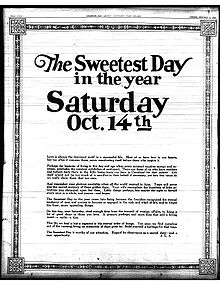This is an old revision of this page, as edited by 174.252.225.191 (talk) at 12:24, 20 October 2012 (Added truth.). The present address (URL) is a permanent link to this revision, which may differ significantly from the current revision.
Revision as of 12:24, 20 October 2012 by 174.252.225.191 (talk) (Added truth.)(diff) ← Previous revision | Latest revision (diff) | Newer revision → (diff)| Sweetest Day | |
|---|---|
| Observed by | Mostly Midwestern United States & Mostly in Cleveland |
| Type | Local |
| Celebrations | Giving small presents such as greeting cards, candy, and flowers to loved ones |
| Date | Third Saturday in October |
| 2025 date | date missing (please add) |
Sweetest day was created by candy makers as an opportunity for women to treat there men to even out the valentines day holiday. Sweetest Day is a holiday celebrated primarily in the Great Lakes region, and parts of the Northeast United States, on the third Saturday in October. It is described by Retail Confectioners International as an "occasion which offers all of us an opportunity to remember the sick, aged and orphaned, but also friends, relatives and associates whose helpfulness and kindness we have enjoyed." Sweetest Day has also been referred to as a "concocted promotion" created by the candy industry solely to increase sales of sweets.
Origin

The first Sweetest Day was pronounced as February 25,1922 in Cleveland, Ohio. The Cleveland Plain Dealer's February 25, 1922 edition, which chronicles the first Sweetest Day in Cleveland, states that the first Sweetest Day was planned by a committee of 12 confectioners chaired by candymaker C. C. Hartzell. The Sweetest Day in the Year Committee distributed over 20,000 boxes of candy to "newsboys, orphans, old folks, and the poor" in Chicago, Illinois.
There were also several attempts to start a "Sweetest Day" in New York City, including a declaration of a Candy Day throughout the United States by candy manufacturers on October 8, 1922. In 1927, The New York Times reported that "the powers that determine the nomenclature of the weeks of October" decreed that the week beginning on October 10, 1927 would be known as Sweetest Week. On September 25, 1937, The New York Times reported under Advertising News and Notes that The National Confectioners Association had launched a "movement throughout the candy industry" to rank Sweetest Day with the nationally accepted Mother's Day, Father's Day, and St. Valentine's Day. In 1940, another Sweetest Day was proclaimed on October 19. The promotional event was marked by the distribution of more than 10,000 boxes of candy by the Sweetest Day Committee. The candy was distributed among 26 local charities. 225 children were given candy in the chapel at the Society for Prevention of Cruelty to Children on October 17, 1940. 600 boxes of candy were also delivered to the presidents of the Jewish, Protestant and Catholic Big Sister groups of New York.
How it's celebrated
Friends, family, and lovers often give each other candy, flowers, and cards on the Sweetest Day. Like Valentine's Day, the Sweetest Day is associated with heart-shaped boxes, and the colors pink and red.
Regional importance
Retail Confectioners International describes it as "much more important for candymakers in some regions than in others (Detroit and Cleveland being the biggest Sweetest Day cities)". The popularity in Detroit was greatly perpetuated by the Sanders Candy Company. Frederick Sanders of Detroit, MI was a large promoter of the holiday. In 2006, Hallmark marketed 151 greeting card designs for Sweetest Day. American Greetings marketed 178.
Criticism
Since Sweetest Day was invented by commercial interests which stood to profit from such a holiday, dissenting Cleveland residents refer to it as a "Hallmark holiday" (although it was not invented by Hallmark Cards company).
References
- Cridlin, Jay (2006-10-21). "A sweet day for Hallmark". St Petersburg Times. Retrieved 2007-02-21.
- ^ Sweetest Day, retailerconfectioners.org. Retrieved on 2007-02-21.
- The Cleveland Plain Dealer, October 15, 2005.
- The New York Times, October 8, 1922.
- The New York Times, October 10, 1927.
- The New York Times, September 25, 1937.
- ^ The New York Times, October 18, 1940.
- Orsborn, Kimberly (2006-10-20). "Sweetest Day born in Ohio". Mount Vernon News. Archived from the original on 2007-03-26. Retrieved 2007-02-21.
- Arnett, Lisa. "Sweet wine o' mine". The Chicago Tribune. Retrieved 2007-02-21.
Further reading
- Maud Lavin, ed. (2004-10-04). The Business of Holidays. Monacelli. ISBN 1-58093-150-2.
- Scott C. Martin (1997). "Consumer Rites: The Buying and Selling of American Holidays". Journal of Social History. 31.
- Bennett Madison and James Dignan (2002-12-28). I Hate Valentine's Day. Simon Spotlight Entertainment. ISBN 0-689-87372-7.
External links
- Michael Webb. History of Sweetest Day "Origins and Facts About Sweetest Day". TheRomantic.com.
{{cite web}}: Check|url=value (help) - "Sweetest Day was born from one man's kindness…not in the laboratory of a greeting card company". American Greetings Corporation. 2004.
{{cite web}}: Unknown parameter|month=ignored (help) - "Sweetest Day 2005". Hallmark Cards. 2005.
{{cite web}}: Unknown parameter|month=ignored (help) - Samira Kawash. "The First Candy Day, 1916". CandyProfessor.com.
- History and Celebration of Sweetest Day